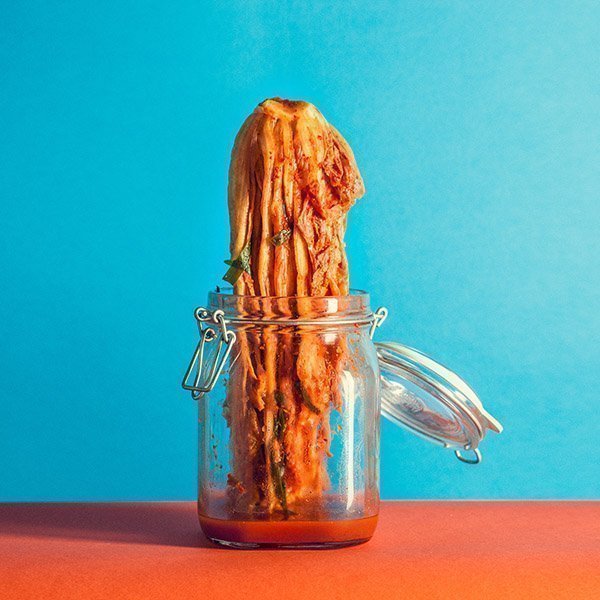In the West, kimchi may sound exotic, adventurous and like a sensory journey, but its literal translation sounds far less poetic and legendary than you might think. Kimchi comes from an ancient Korean term that means “fermented vegetables”. Goodbye oriental magic; hello popular dish. Kimchi is traditionally served on every Korean table, regardless (this time) of North of South. Like pasta in Italy and bread in Spain—kimchi is Korea’s superhero. This is why some might be shocked to see their staple become so popular beyond their borders. Famous chefs, street food enthusiasts and fusion restaurants have all experimented with these fermented greens in their recipes.
A superfood
Kimchi’s main ingredient is usually bok choy, although depending on the area and time of year, it can also be made with radishes, cucumbers and green onions. But how did kimchi come about? It’s simple—Korea’s cold winters, especially those in the North, made it difficult for residents to plant cabbage, which was their main sustenance all year round. So they began fermenting the vegetables at the beginning of autumn, just like the tradition of canned goods in Spain. For fermentation (recipes many vary according to region), families typically use sun dried red chili peppers, red bell peppers, garlic, peeled and diced lemons, rice vinegar, sesame oil, salted fish, salt; either myeolchijeot, fermented anchovies in brine, or saeujeot (fermented shrimp in brine), and myeolchiaekjeot, an anchovie’s jeot liquid similar to fish sauce used in South Asia. The small shrimp and anchovies are previously boiled to reduce the smell and get rid of the fat. The resulting mixture is combined with the pul (thickening rice powder) or wheat semolina. When ready, it is stored underground in clay pots that withstand changes in temperature or, more recently, in special refrigerators that regulate it.
As we said before, kimchi is such a mainstay in the Korean kitchen that it is not only eaten on its own (although it is)—it is also used in stews, soups, rice and noodle dishes, and as a filling for small empanadas… Not since the 7th century when first praised for its medicinal properties has Kimchi again been recognized and subjected to new studies. The result? Kimchi is a superfood. It is a ‘live’ food because of its lactic fermentation that helps intestinal cleansing and the creation of juices that stimulates the appetite. Besides, it is rich in carotenes, proteins, calcium, and carbohydrates, plus vitamins A, B1, B2 and C. Other data highlights that it helps fight cholesterol and is an antioxidant as raw vegetables preserve all their properties in this type of conservation method. A study from 2008 by the the Korean Microbiology and Biotechnology Journal revealed that kimchi contains high quantities of a strain of bacteria (Lactobacillus plantarum NO1) that prevents the development of cancer cells by more than 33%.
In Japan it’s called kimuchi
Beyond their super powers, similar to the famous sauerkraut (fermented cabbage in a brine typical from Germany, Poland and Russia), kimchi has become a trend in gastronomy outside its borders. Besides China, who adopted it centuries ago, the Japanese have used it to make one of their most common artificial flavor enhancers in today’s world food market: instant soups, precooked meals, sodas—almost anything whose taste resembles kimchi. But there’s more: in 1996, the Japanese wanted kimuchi, as they pronounce it, to be an official dish at the Atlanta Olympic games—an issue that opened wounds among Koreans and almost led to a diplomatic conflict.
Today, kimchi’s passport is stamped with the Korean seal and can find its way into kitchens around the world where creative chefs can work their magic. One such dish is the famous Kimchi Maison that Chef/Owner Estanislao Carenzo has created at Sudestada restaurant in Madrid. He prepares it with a mix of bok choy, Galician mussels, Mexican chili and sea water. We can also find sea crisp made with kimchi and Pakta algae dust at Albert Adria’s Nikkei restaurant in Barcelona. Several chefs in these pages have also fallen for its charms: Magnus Nilsson, from Faviken Magasinet uses gungmul kimchi (watery kimchi juice) as a dressing for raw horse mackerel. Thomas Bühner, from the three-Michelin-star German restaurant La Vie, turns it into dust for a game between shrimp and algae. Need more convincing to give it a try?
Photography Alfonso Herranz / Alicia
kimchi by gayagum (Bordadores 7, Madrid)

